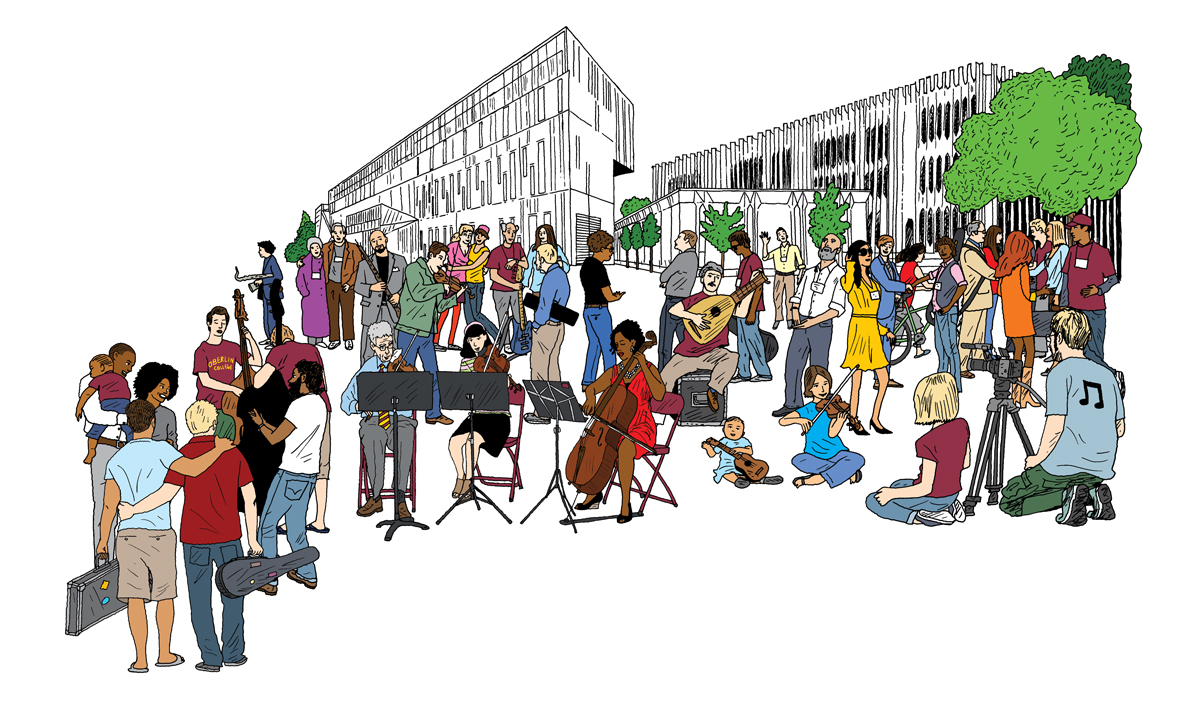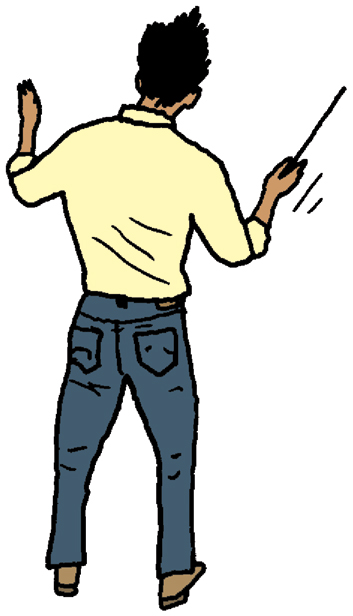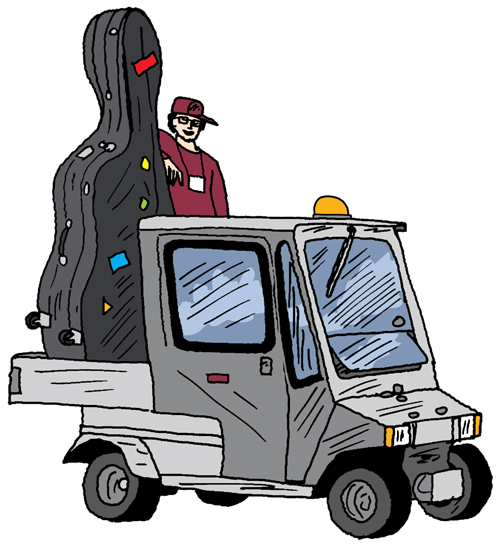Always an Obie

The 2012 Conservatory Reunion and Celebration reignited passions on campus and beyond
by Andrew Willens '11
Illustrations by Peter Arkle
On a warm and cloudless night in June 2011, one hundred alumni of the Oberlin Conservatory gathered on a New York City rooftop to convene with old friends, some of whom they hadn't seen in decades.
The guests marveled at the garden setting and the picturesque view of the star-speckled Manhattan skyline, but host Lee Koonce '82 attributed the great turnout to much more than a stunning location.
"We have conservatory alums who want to be involved. They're hungry to be engaged," says the pianist and executive director of New York's Third Street Music School, the oldest community music school in America. For Koonce, the informal gathering was a signal to act on his vision for a first-of-its-kind conservatory reunion and celebration on campus—an idea he had discussed at length with Oberlin administrators and colleagues on the Oberlin Alumni council. A year later, that vision became reality.
In June 2012, nearly 200 alumni returned to Oberlin from as far away as Washington, Florida, California, and Germany, and representing classes dating as far back as 1944. For one long weekend, they performed in venues across campus, shared laughs about conservatory life, debated passionately, and honored alumni who have passed.
For many, it was a flashback to a life remembered fondly.
“For the first time in a very long time, I got to feel like a student again,” says David H. Stull, dean of the conservatory and a 1989 graduate. “It reminded me that for a period of about five years, day after day after day, the world was always like that.”
For organizers like Koonce, the reunion represents one brick in the foundation of what they hope will become a lasting tradition.
“This reunion is a time to reconnect with friends, make new friends, rekindle your passion for music, and rekindle your passion for Oberlin,” Koonce said in his opening address to returning graduates. “It’s about building a network of conservatory alumni.”
A World of Connections
That network, composed of small communities clustered around similar interests and scattered across the country, is widely considered one of the conservatory’s most valuable resources.
“For those of you who live in New York, San Francisco, Philadelphia, Washington, D.C., or elsewhere, I think you would describe Oberlin as having this wonderful sort of sleeper-cell network,” Stull told alumni. “This means that when you move to one of these places and run into an alum, they can get you connected.”
 In Minneapolis, for example, venues and events featuring contemporary classical music—such as the Walker Art Center, Southern Theater, and the American Composers Forum—regularly draw musicians and ensembles with ties to Oberlin, including So Percussion and the International Contemporary Ensemble (ICE).
In Minneapolis, for example, venues and events featuring contemporary classical music—such as the Walker Art Center, Southern Theater, and the American Composers Forum—regularly draw musicians and ensembles with ties to Oberlin, including So Percussion and the International Contemporary Ensemble (ICE).
“Oberlin is such a thriving contemporary music breeding ground,” says Mandy Tuong ’02, a pianist, attorney, and former board chair at the Macphail Center for Music in Minneapolis. “Almost every month, someone was coming from Oberlin to perform or have their work performed. I felt like I was never away from it.” (Tuong, who recently relocated to san Francisco, succeeded Koonce as chair of the Alumni Council’s Conservatory Committee in the fall of 2012.)
The reunion hinted at the wide variety of fields in which these communities are found, from musical performance and education to business and the sciences. pianist and University of North Carolina professor Patricia Gray ’67 offered an extensive presentation on her research regarding the biology of music, which focuses on the ability of certain apes to recognize rhythm. In a seminar on innovation in the business of music, Eugene Carr ’82 described his path from cello performance to managing nonprofits and businesses such as the American symphony Orchestra and Patron Technology, his current company, which provides marketing software to arts organizations.
In many cases, alumni are drawn to one another by a shared set of personal and professional values, which they often learned at Oberlin and continue to hold in high regard.
“I love it when I meet someone who’s gone to Oberlin,” says Seth Rudetsky ’88, a Broadway renaissance man who has performed in and produced shows such as Les Misérables and Dreamgirls, in addition to writing several books and hosting two Sirius/XM radio shows.
“For the first time in a very long time,
I got to feel like a student again.”
“You just assume they have the same values you do, that they’re smart, and they’re creative,” he says. “It’s just a very smart, creative, artistic, appreciative atmosphere.”
Rudetsky attributes these characteristics in part to Oberlin’s collaborative, industrious environment. For him, campus life was an entrepreneurial laboratory—the testing ground for an approach to producing performances that he still uses today. As a first-year student, he recruited an entire orchestra of friends and classmates to collaborate on his winter-term performance of George Gershwin’s Rhapsody in Blue.
He applied the same tactic to Broadway in 2001, drawing on friends such as five-time Tony Award-winner Audra McDonald to stage a production of Dreamgirls that sold out and raised nearly $1 million for a nonprofit group that provides social services to performers.
“My whole career has been like that: commandeering people to do big, fun projects,” Rudetsky says. “I kind of learned at Oberlin that if no one’s going to hand it to you, you can just do it yourself.”
At the reunion, Rudetsky produced the Cabaret Dinner, a performance of show and film tunes tracing the career of Judy Kuhn ’81, a soprano famous for roles such as Cosette in the 1987 Broadway premiere of Les Misérables.
“It’s our intention to build this network of conservatory alumni,
and this is the beginning.”
From two barstools and a piano in the root room of the carnegie Building, the two relived the highs and often-humorous lows of Kuhn’s career, from recording “Colors of the Wind” for Disney’s Pocahontas to forgetting a verse while performing at the 1987 Tony Awards.
It’s a slip Rudetsky remembers viewing “obsessively” at the Conservatory Library in his days on campus, and he delighted in playing it again for fellow alumni.
“Seth wants to embarrass me now,” Kuhn joked, as Rudetsky cued up the clip for the first of three times.
Oberlin on Tour
One of the conservatory's priorities is to forge connections with its many small communities of graduates. many of them, Koonce says, exist in complete isolation from Oberlin simply because they hadn’t thought to reach out.
For 19 years following his graduation, Matthew Liebendorfer ’83 focused intently on his career as a programming consultant, losing touch with his violin and the Oberlin community. But he was inspired to reconnect with both several years ago during his college reunion. For the conservatory reunion, he organized 18 musicians and a series of chamber music sessions to tackle an ambitious goal: playing all of the Haydn string quartets in the standard repertoire.
“It wasn’t quite a cycle,” he says. “But we played 42 of the 56 quartets that people frequently play, in about 48 hours. It was really a hoot.”
 Today, Liebendorfer maintains close ties to Oberlin and organizes opportunities for alumni to play together, including chamber music sessions for the classes of ’82, ’83, and ’84 at Oberlin’s 2013 commencement and reunion weekend.
Today, Liebendorfer maintains close ties to Oberlin and organizes opportunities for alumni to play together, including chamber music sessions for the classes of ’82, ’83, and ’84 at Oberlin’s 2013 commencement and reunion weekend.
“I just want to have fun,” he says, “but the more I give to this...the more it’s paid off in spades.”
Connecting with Oberlin, Dean Stull says, can also be of enormous benefit to current students and recent graduates.
“The best thing that we can do for our graduates is get them to know each and every one of you,” he said during his State of the Conservatory Address. “Especially in today’s world, whether you’re in music or you’re out of music, the people you know, what you know about the city, the things you are working on—all this provides the exceptionally talented people we have coming out of Oberlin with great opportunities.”
To foster these connections, the conservatory is presenting regional performances in major urban centers across the country, providing alumni and current students opportunities to meet each other as performers. As part of the college’s recently launched Oberlin Illuminate campaign, for example, several Oberlin ensembles performed to enthusiastic crowds of alumni at Carnegie Hall, the Dimenna Center, and other famed New York locales in January. Similar events are being considered in other cities as well.
In recent months, conservatory concerts have become available for real-time viewing online. Listen Live!, which streams programs held in Finney Chapel, Kulas Recital Hall, Warner Concert Hall, Clonick Recording Studio, and Fairchild Chapel, launched in September 2012 with a concert in Finney Chapel that featured the Oberlin Orchestra and Contemporary Music Ensemble.
If all goes according to plan, Koonce says, regional alumni events will be organized around these streamed concerts, much like the Metropolitan Opera’s “Live in HD” program, which broadcasts performances to faraway movie theaters. In the coming years, additional conservatory reunions on campus may come into focus as well.
“It’s our intention to really build this network of conservatory alumni, and this is the beginning,” Stull said in his closing remarks. “Please tell your friends they won’t regret coming back and remembering why this place was so special and what it did for all of us.”
Thriving Amid Crisis
What alumni can do to bolster music education in America
Obies are naturally good educators—just ask David H. Stull. At the Oberlin Conservatory reunion and celebration in June 2012, the dean found himself responding to passionate inquiries about what the conservatory is doing to support music education during challenging financial times.
“Oberlin is unique among the top conservatories in the world in that it attracts individuals who play at an incredibly high level and can teach,” he said. “Almost every Oberlin graduate I have ever encountered has this desire—and willingness— to give back to somebody else. It’s a collective spirit.”
That desire was so strong at the reunion that questions about the conservatory’s educational programs spilled out a day in advance of the panel discussion dedicated to the subject.
“I still remember the feeling of having a violin under my chin for the first time,” said teacher and freelance musician Lisa Whitfield ’90 at a panel on innovation in the music industry. “I still love the smell of rosin. How do we individually give these children that passion? How do we light a fire under ourselves to pick up that torch?”
While growing up in Philadelphia, Whitfield said in an interview, she learned to play viola and violin through the music program at her public school, which provided everything from ensemble opportunities to instruments and private lessons free of charge. Had the program not been free, she says, Whitfield’s family would not have been able to pay for it—and she probably would not have pursued a career in music.
“Today,” she adds, “there is a huge divide between the wealthy, who are able to afford the arts, and the rest of us.”
Whitfield, who has performed with renowned artists such as Ray Charles, taught for nearly two decades in the Music Advancement Program at Juilliard, which targets students in racial demo- graphics that are under- represented in the performing arts. She moved to Oberlin in 2006 and now teaches in the Lakewood public school system near Cleveland.
Even in the face of America’s languishing economy, the conservatory is exploring new frontiers in music education.
Music in America, for example, establishes and recognizes innovative education programs that use music to build critical academic and life skills in urban and underserved communities throughout the U.S. Select faculty in K-12 schools are named Music in America Fellows and invited to participate in an annual conference at Oberlin, where they document best practices for teaching and work directly with conservatory students. Launched in 2011, the program has raised $500,000 in partnership with the conservatory’s innovative Master of Music Teaching program.
These programs, Stull emphasizes, are training students to be fearless advocates of music education. And that role, he says, is one that all Obies should adopt.
“Each one of us graduated from this institution, and we understand what needs to be done,” Stull said at the panel discussion on music education. “So I’m going to charge you to take action: Tell the school board, parents, administrators, and executive directors in your community that you’re going to change the world and that you need their help. And of course, remember your Oberlin partners and friends—the reason we’re having this reunion is the network.”
Andrew Willens lives in New York City, where he is involved in environmental policy and is pursuing a new love: swing dancing.
